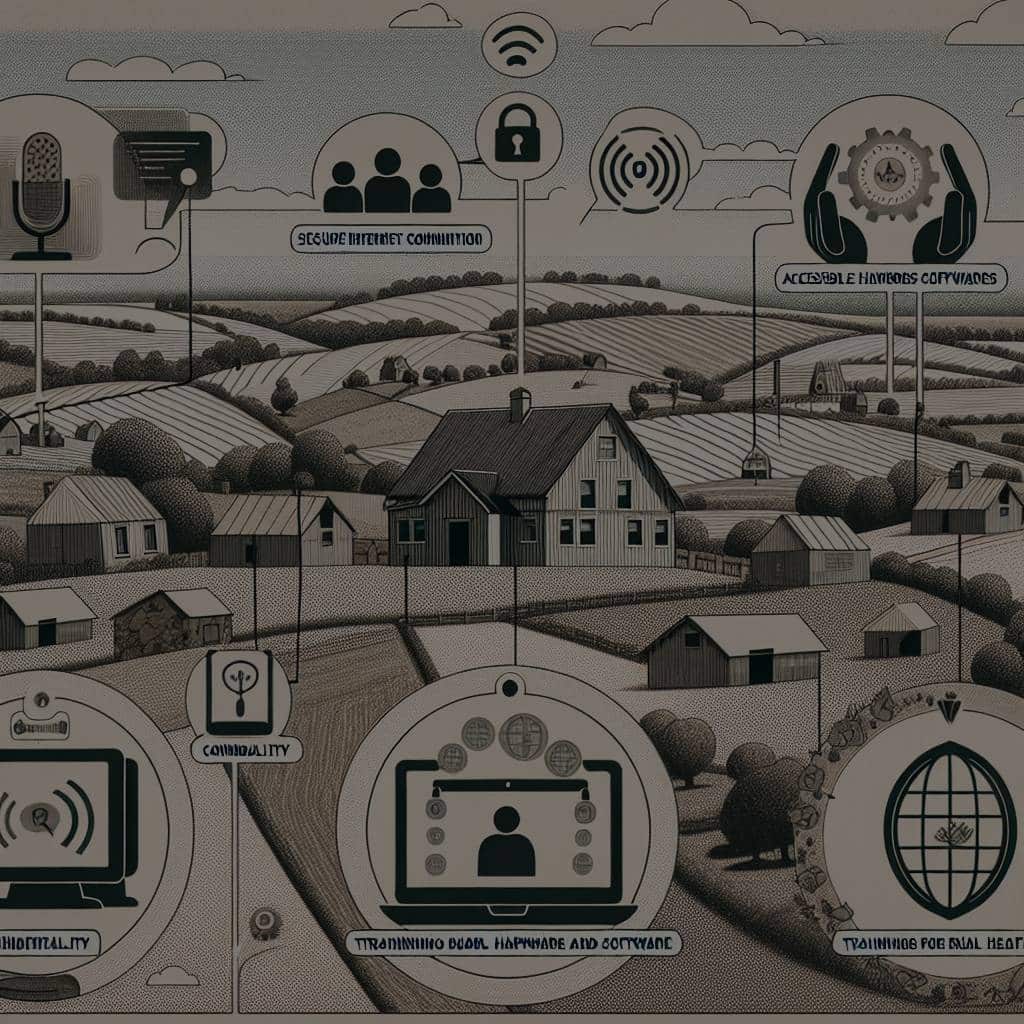What Are the Best Practices for Implementing Telepsychiatry in Rural Communities?

Telepsychiatry, a subset of telehealth, is transforming the landscape of mental healthcare, particularly in rural areas. As the integration of technology into healthcare continues to advance, it offers an essential lifeline for those living in remote regions where access to traditional psychiatric services is often limited.
This article will delve into telepsychiatry, discuss its importance in rural communities, and guide you through the best practices for implementing this innovative approach to healthcare. We will reference authoritative sources like scholarly articles from Google Scholar and PubMed to support our discussion.
This might interest you : Can the Use of Compression Garments Enhance Athletic Recovery and Performance?
Understanding Telepsychiatry and Its Importance in Rural Communities
Before we dive into best practices, it’s crucial to comprehend what telepsychiatry is and why it’s particularly vital for rural communities.
Telepsychiatry, a branch of telemedicine, involves providing mental health services remotely via video conferencing or other technology-based methods. This approach enables mental health providers to reach patients who might otherwise struggle to access these services due to geographical constraints, lack of transportation, or limited local resources.
Also to discover : How Does Community Access to Clean Water Impact Children’s Health and Education?
Rural communities, often underserved by conventional healthcare services, can greatly benefit from telepsychiatry. With access to quality mental health care often restricted by factors such as limited numbers of local providers and long travel distances, telepsychiatry offers a viable solution.
By implementing telepsychiatry, rural residents can receive essential care from the comfort of their own homes, reducing travel time and expenses. It also facilitates faster interventions during crises, which can significantly affect patient outcomes.
Key Considerations for Implementing Telepsychiatry in Rural Areas
Implementing telepsychiatry in rural areas involves more than just introducing technology. Several key factors should be carefully considered to ensure the successful integration of these services.
One vital consideration is the infrastructure available in the rural community. Are reliable internet services and appropriate devices readily accessible? Without a stable internet connection or suitable equipment, the delivery of telepsychiatry services could be hindered.
Another aspect to consider is the comfort level of both patients and providers in using technology. Training may be required to help all parties become familiar with the telepsychiatry platform. This not only includes learning how to use the technology but also understanding privacy and security protocols.
Lastly, it’s essential to consider how to promote the program effectively. Awareness is crucial in encouraging rural residents to take advantage of the available services.
Best Practices for Telepsychiatry Implementation
Having considered these factors, let’s look at some best practices for implementing telepsychiatry in rural areas.
Firstly, partner with local healthcare providers. Building relationships with local primary care clinics can help integrate telepsychiatry services into existing healthcare delivery structures. These partnerships can also help telepsychiatry providers gain a better understanding of the community’s unique needs and challenges.
Secondly, involve the community. Engage community members in the planning and implementation of telepsychiatry services. They can provide invaluable insight into local concerns, potential barriers, and the best ways to promote the service.
Thirdly, provide comprehensive training. As mentioned earlier, both providers and patients may require training to use the telepsychiatry platform effectively. This should include instructions on using the technology, understanding the process of a telepsychiatry session, and ensuring privacy and security.
Lastly, create a supportive environment. This involves providing ongoing support for both patients and providers during the implementation process and beyond. Regular check-ins, feedback sessions, and providing resources for technical troubleshooting can help build confidence and facilitate the successful integration of telepsychiatry services.
Overcoming Challenges: Lessons from Scholarly Sources
As with any new initiative, implementing telepsychiatry in rural areas comes with its own set of challenges. However, many of these can be overcome with the right strategies, as shown by numerous studies available on platforms such as Google Scholar and PubMed.
For instance, issues related to technology, such as unreliable internet connections and lack of equipment, can be addressed by partnering with local organizations or government entities. They may be able to provide resources or support to improve the technology infrastructure necessary for telepsychiatry.
Additionally, studies suggest using hybrid models of care where telepsychiatry is combined with in-person services. This approach can help overcome resistance to using technology and build trust within the community.
Finally, to address privacy and security concerns, it’s crucial to ensure the telepsychiatry platform complies with healthcare regulations and industry standards. Regular updates and security checks can also help maintain the integrity of the platform.
The Future of Telepsychiatry in Rural Communities
Looking forward, telepsychiatry has enormous potential to reshape mental health care in rural communities. As technology continues to improve and become more accessible, it’s expected that telepsychiatry will become an increasingly integral part of mental health care delivery.
However, to ensure the success of these services, continuous improvement and adaptation are crucial. Feedback from patients and providers should be regularly sought and taken into account when refining the service. Moreover, ongoing training and support for both patients and providers will be key in ensuring the sustainability of telepsychiatry services.
Addressing Legal and Ethical Considerations in Telepsychiatry
When implementing telepsychiatry, acknowledging and addressing the legal and ethical considerations is crucial. These considerations often revolve around patient privacy, confidentiality, and informed consent.
Telepsychiatry services, like other health services, must comply with the Health Insurance Portability and Accountability Act (HIPAA). This act protects the privacy of individuals’ health information. Therefore, telepsychiatry platforms must ensure they have robust security features in place to prevent data breaches and protect patient privacy.
Informed consent is another important factor. Providers must ensure that patients understand how telepsychiatry sessions work, their rights and responsibilities, potential risks, and benefits, as well as alternatives to telepsychiatry. This information should be conveyed in a simple, easy-to-understand manner to ensure patient comprehension.
Furthermore, the issue of jurisdiction should be considered. In most cases, health care providers are only licensed to practice in specific states. Therefore, they should be aware of the laws governing telehealth services in the patient’s location.
For addressing these concerns, providers can refer to guidelines and resources available from reputable sources, including Google Scholar, PubMed, and Crossref. Following best practices derived from these resources can help ensure that telepsychiatry services are delivered in an ethical and legal manner.
Conclusion: The Role of Telepsychiatry in Enhancing Rural Mental Health Care
Telepsychiatry holds great promise in addressing the mental health needs of rural communities. By overcoming geographical barriers and leveraging technology, it can significantly enhance access to mental health services for rural patients. Successful implementation, however, requires careful planning, an understanding of the community’s unique needs, and a commitment to ongoing support and improvement.
It’s important to remember that while technology plays a pivotal role in telepsychiatry, it is merely a tool. The heart of effective mental health care remains the therapeutic relationship between patient and provider. Therefore, despite the distance, providers must strive to build trust, understanding, and empathy in their interactions with patients.
Moreover, to ensure the sustainability of telepsychiatry services, active engagement with the community is crucial. This includes promoting awareness about the services, addressing any concerns or barriers, and continually seeking feedback to improve the service.
According to scholarly sources like PubMed, Google Scholar, and Crossref, telepsychiatry has the potential to greatly enhance rural mental health care. By adhering to best practices and continually adapting to meet the needs of the community, healthcare providers can harness the power of technology to deliver high-quality psychiatric care to those in rural areas.
In summary, telepsychiatry is more than an innovative approach to healthcare; it’s an opportunity to create a more inclusive, accessible, and efficient mental health system that truly serves the needs of all communities, regardless of location.
